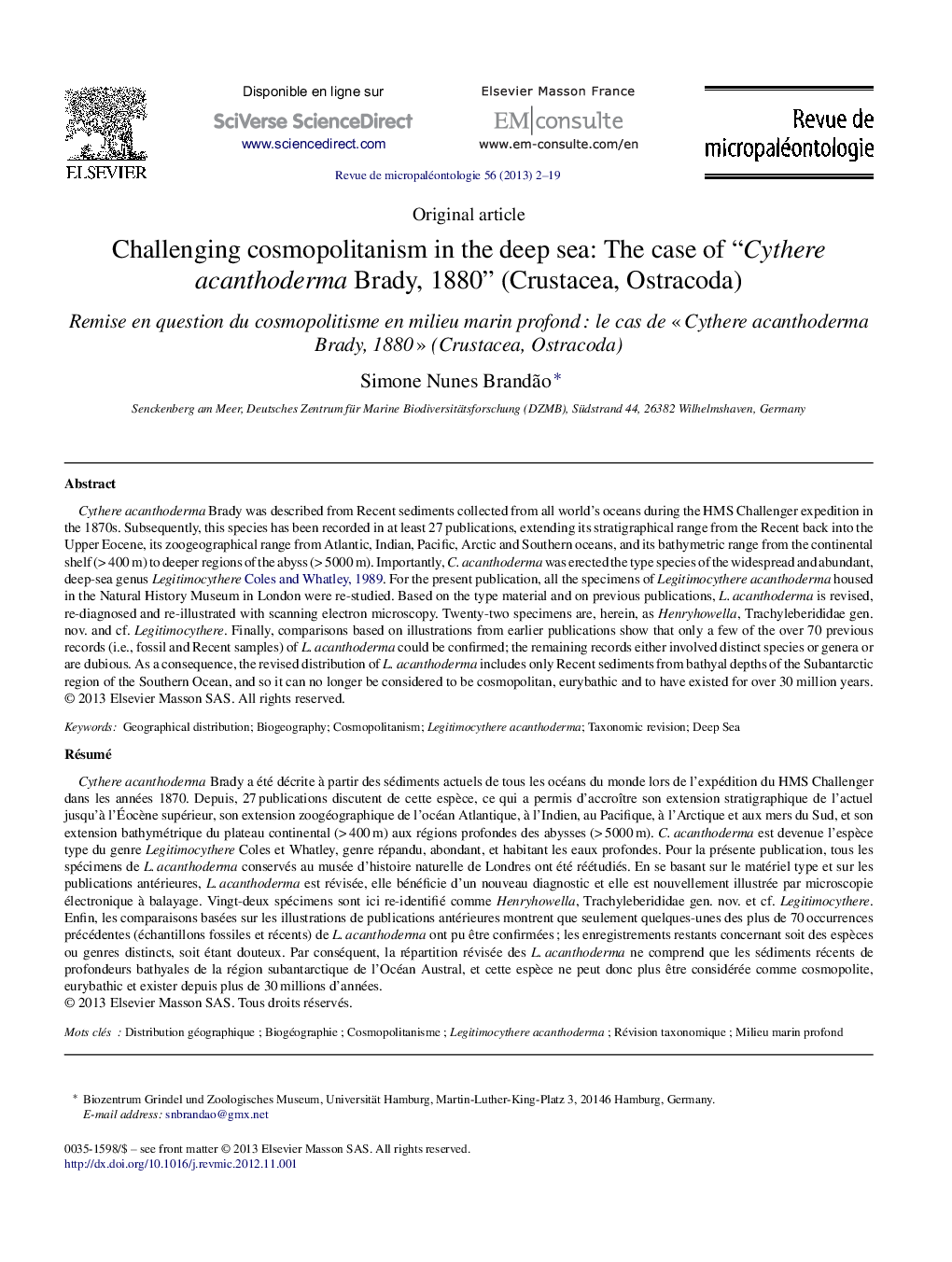| کد مقاله | کد نشریه | سال انتشار | مقاله انگلیسی | نسخه تمام متن |
|---|---|---|---|---|
| 4751430 | 1361062 | 2013 | 18 صفحه PDF | دانلود رایگان |

Cythere acanthoderma Brady was described from Recent sediments collected from all world's oceans during the HMS Challenger expedition in the 1870s. Subsequently, this species has been recorded in at least 27 publications, extending its stratigraphical range from the Recent back into the Upper Eocene, its zoogeographical range from Atlantic, Indian, Pacific, Arctic and Southern oceans, and its bathymetric range from the continental shelf (> 400 m) to deeper regions of the abyss (> 5000 m). Importantly, C. acanthoderma was erected the type species of the widespread and abundant, deep-sea genus Legitimocythere Coles and Whatley, 1989. For the present publication, all the specimens of Legitimocythere acanthoderma housed in the Natural History Museum in London were re-studied. Based on the type material and on previous publications, L. acanthoderma is revised, re-diagnosed and re-illustrated with scanning electron microscopy. Twenty-two specimens are, herein, as Henryhowella, Trachyleberididae gen. nov. and cf. Legitimocythere. Finally, comparisons based on illustrations from earlier publications show that only a few of the over 70 previous records (i.e., fossil and Recent samples) of L. acanthoderma could be confirmed; the remaining records either involved distinct species or genera or are dubious. As a consequence, the revised distribution of L. acanthoderma includes only Recent sediments from bathyal depths of the Subantarctic region of the Southern Ocean, and so it can no longer be considered to be cosmopolitan, eurybathic and to have existed for over 30 million years.
RésuméCythere acanthoderma Brady a été décrite à partir des sédiments actuels de tous les océans du monde lors de l’expédition du HMS Challenger dans les années 1870. Depuis, 27 publications discutent de cette espèce, ce qui a permis d’accroître son extension stratigraphique de l’actuel jusqu’à l’Éocène supérieur, son extension zoogéographique de l’océan Atlantique, à l’Indien, au Pacifique, à l’Arctique et aux mers du Sud, et son extension bathymétrique du plateau continental (> 400 m) aux régions profondes des abysses (> 5000 m). C. acanthoderma est devenue l’espèce type du genre Legitimocythere Coles et Whatley, genre répandu, abondant, et habitant les eaux profondes. Pour la présente publication, tous les spécimens de L. acanthoderma conservés au musée d’histoire naturelle de Londres ont été réétudiés. En se basant sur le matériel type et sur les publications antérieures, L. acanthoderma est révisée, elle bénéficie d’un nouveau diagnostic et elle est nouvellement illustrée par microscopie électronique à balayage. Vingt-deux spécimens sont ici re-identifié comme Henryhowella, Trachyleberididae gen. nov. et cf. Legitimocythere. Enfin, les comparaisons basées sur les illustrations de publications antérieures montrent que seulement quelques-unes des plus de 70 occurrences précédentes (échantillons fossiles et récents) de L. acanthoderma ont pu être confirmées ; les enregistrements restants concernant soit des espèces ou genres distincts, soit étant douteux. Par conséquent, la répartition révisée des L. acanthoderma ne comprend que les sédiments récents de profondeurs bathyales de la région subantarctique de l’Océan Austral, et cette espèce ne peut donc plus être considérée comme cosmopolite, eurybathic et exister depuis plus de 30 millions d’années.
Journal: Revue de Micropaléontologie - Volume 56, Issue 1, January–March 2013, Pages 2–19